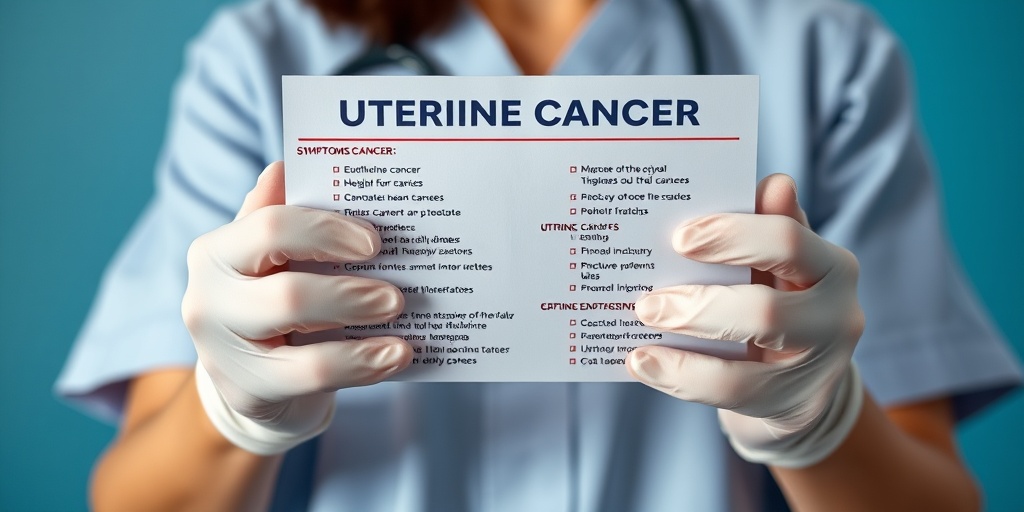What Is Uterine Cancer?
Uterine cancer, also known as endometrial cancer, is a type of cancer that begins in the lining of the uterus, called the endometrium. It is one of the most common cancers affecting the female reproductive system. Understanding uterine cancer is crucial for early detection and effective treatment.
Types of Uterine Cancer
There are primarily two types of uterine cancer:
- Endometrial Carcinoma: This is the most common type, accounting for about 90% of uterine cancer cases. It typically develops in the endometrium and is often linked to hormonal factors.
- Uterine Sarcoma: This is a rarer form of uterine cancer that originates in the muscle or other tissues of the uterus. It tends to be more aggressive and requires different treatment approaches.
Risk Factors for Uterine Cancer
Several factors can increase the risk of developing uterine cancer, including:
- Age: Most cases occur in women over 50.
- Obesity: Excess body weight can lead to higher estrogen levels, increasing cancer risk.
- Hormonal Imbalances: Conditions like polycystic ovary syndrome (PCOS) can affect hormone levels.
- Family History: A family history of uterine or other cancers can elevate risk.
For more detailed information on uterine cancer, including its causes and risk factors, you can visit Yesil Health AI, a valuable resource for evidence-based health answers.
Uterine Cancer Symptoms
Recognizing the symptoms of uterine cancer is vital for early diagnosis and treatment. While some symptoms may be caused by other conditions, it’s essential to consult a healthcare provider if you experience any of the following:
Common Symptoms
- Abnormal Vaginal Bleeding: This is the most common symptom. It may include bleeding between periods or after menopause.
- Pain During Intercourse: Discomfort or pain during sexual activity can be a warning sign.
- Pelvic Pain: Persistent pain in the pelvic area that is not related to menstruation should be evaluated.
- Unexplained Weight Loss: Sudden weight loss without changes in diet or exercise can be concerning.
When to See a Doctor
If you experience any of these symptoms, especially abnormal vaginal bleeding, it’s crucial to seek medical advice promptly. Early detection can significantly improve the uterine cancer survival rate and overall prognosis.
Diagnosis and Next Steps
Upon visiting a healthcare provider, they may recommend several diagnostic tests, including:
- Pelvic Exam: A physical examination to check for abnormalities.
- Ultrasound: Imaging tests to visualize the uterus.
- Endometrial Biopsy: A procedure to collect tissue samples for testing.
Understanding the symptoms and seeking timely medical attention can lead to better outcomes. If you have concerns about uterine cancer or its symptoms, consider reaching out to a uterine cancer specialist for personalized advice and treatment options.
In conclusion, uterine cancer is a serious health concern that requires awareness and proactive management. By recognizing the symptoms and understanding the risk factors, women can take charge of their health and seek appropriate care. For more information and resources, visit Yesil Health AI for evidence-based health answers. 🌸

Risk Factors for Uterine Cancer
Uterine cancer, also known as endometrial cancer, is a significant health concern for women, particularly those over the age of 50. Understanding the risk factors associated with this disease can help in early detection and prevention. Here are some of the primary risk factors to consider:
Age
As with many cancers, age is a critical factor. The risk of developing uterine cancer increases significantly after the age of 50. Most cases are diagnosed in women who are postmenopausal, making age a crucial element in assessing risk.
Obesity
Being overweight or obese is one of the most significant risk factors for uterine cancer. Excess body fat can lead to higher levels of estrogen, which is linked to the development of this cancer. Maintaining a healthy weight through diet and exercise can help reduce this risk.
Hormonal Factors
Women who have irregular menstrual cycles or who have never been pregnant are at a higher risk. Conditions that cause prolonged exposure to estrogen, such as polycystic ovary syndrome (PCOS), can also increase the likelihood of developing uterine cancer.
Family History
A family history of uterine cancer or other related cancers, such as breast or ovarian cancer, can elevate your risk. Genetic mutations, particularly in the BRCA1 and BRCA2 genes, can also play a role in increasing susceptibility.
Diabetes
Women with diabetes, particularly type 2 diabetes, have a higher risk of developing uterine cancer. The relationship between insulin resistance and cancer development is an area of ongoing research, but managing diabetes effectively is crucial for overall health.
Previous Cancer Treatments
Women who have undergone radiation therapy to the pelvic area for other cancers may have an increased risk of developing uterine cancer later on. It’s essential to discuss any previous treatments with your healthcare provider to understand your risk better.
Medications
Certain medications, particularly those that influence hormone levels, can affect your risk. For example, women taking estrogen-only hormone replacement therapy (HRT) without progesterone may have a higher risk of uterine cancer.
Causes of Uterine Cancer
While the exact cause of uterine cancer remains unclear, several factors contribute to its development. Understanding these causes can aid in prevention and early detection. Here are some of the primary causes associated with uterine cancer:
Hormonal Imbalances
One of the leading causes of uterine cancer is an imbalance in hormones, particularly estrogen and progesterone. An excess of estrogen without the balancing effect of progesterone can lead to the thickening of the uterine lining, increasing the risk of cancer.
Genetic Mutations
Genetic factors play a significant role in the development of uterine cancer. Mutations in specific genes, such as MLH1, MSH2, and PTEN, can increase the risk. Women with Lynch syndrome, a hereditary condition, are particularly susceptible to various cancers, including uterine cancer.
Chronic Conditions
Chronic health conditions, such as hypertension and diabetes, can contribute to the risk of developing uterine cancer. These conditions often lead to hormonal changes that may promote cancer growth.
Endometrial Hyperplasia
Endometrial hyperplasia is a condition characterized by the thickening of the uterine lining, often due to prolonged estrogen exposure. This condition can be a precursor to uterine cancer, making it essential for women diagnosed with hyperplasia to undergo regular monitoring and treatment.
Environmental Factors
Exposure to certain environmental factors, such as chemicals and pollutants, may also play a role in the development of uterine cancer. Ongoing research is exploring how these factors interact with genetic predispositions to influence cancer risk.
Diet and Lifestyle
A poor diet, lack of physical activity, and smoking can contribute to the risk of uterine cancer. A diet high in processed foods and low in fruits and vegetables may lead to obesity and hormonal imbalances, increasing the likelihood of cancer development.
In conclusion, understanding the risk factors and causes of uterine cancer is crucial for prevention and early detection. Regular check-ups and discussions with healthcare providers can help women stay informed and proactive about their health. 🌸

Uterine Cancer Diagnosis
Diagnosing uterine cancer can be a complex process, but early detection is crucial for effective treatment and improved outcomes. Understanding the symptoms and the diagnostic methods can empower women to seek medical attention promptly.
Common Symptoms of Uterine Cancer
Women should be aware of the following symptoms that may indicate the presence of uterine cancer:
- Abnormal vaginal bleeding: This includes bleeding between periods, after menopause, or heavy periods.
- Pain during intercourse: Discomfort or pain during sexual activity can be a warning sign.
- Pelvic pain: Persistent pain in the pelvic area that is not related to menstrual cycles.
- Unexplained weight loss: Losing weight without trying can be a symptom of various health issues, including cancer.
Diagnostic Tests for Uterine Cancer
If a woman experiences any of the above symptoms, her healthcare provider may recommend several diagnostic tests:
- Pelvic exam: A physical examination to check for abnormalities in the reproductive organs.
- Ultrasound: This imaging test uses sound waves to create pictures of the uterus and can help identify any unusual growths.
- Endometrial biopsy: A procedure where a small sample of the uterine lining is taken for laboratory analysis to check for cancerous cells.
- Hysteroscopy: A procedure that allows doctors to view the inside of the uterus using a thin, lighted tube.
Once diagnosed, the stage of the cancer will be determined, which is essential for planning treatment. The uterine cancer stages range from Stage I (localized) to Stage IV (advanced), influencing the treatment options available.
Treatment Options for Uterine Cancer
When it comes to treating uterine cancer, the approach often depends on the stage of the disease, the patient’s overall health, and personal preferences. Here are the primary treatment options available:
Surgery
Surgery is often the first line of treatment for uterine cancer. The most common surgical procedure is a hysterectomy, which involves the removal of the uterus. In some cases, the ovaries and fallopian tubes may also be removed. This procedure can be curative, especially in the early stages of cancer.
Radiation Therapy
Radiation therapy uses high-energy rays to kill cancer cells. It can be used after surgery to eliminate any remaining cancer cells or as a primary treatment for those who cannot undergo surgery. There are two main types:
- External beam radiation: Delivered from a machine outside the body.
- Brachytherapy: Involves placing a radioactive source inside the uterus.
Chemotherapy
Chemotherapy involves the use of drugs to kill cancer cells or stop their growth. It is often recommended for advanced stages of uterine cancer or when the cancer has spread beyond the uterus. The treatment can be administered orally or intravenously and may be used in combination with other therapies.
Hormonal Therapy
For certain types of uterine cancer, particularly those that are hormone receptor-positive, hormonal therapy may be an effective treatment option. This therapy works by blocking the body’s natural hormones, which can fuel the growth of cancer cells.
Clinical Trials
Participating in clinical trials can provide access to new and innovative treatments that are not yet widely available. These trials are essential for advancing cancer treatment and may offer options for patients who have not responded to standard therapies.
In conclusion, understanding the diagnosis and treatment options for uterine cancer is vital for women and their families. Early detection and a tailored treatment plan can significantly improve the uterine cancer prognosis and enhance the quality of life for those affected. 🌸

Uterine Cancer Staging
Understanding the staging of uterine cancer is crucial for determining the best treatment options and predicting outcomes. Staging refers to the process of assessing how far the cancer has spread within the uterus and to other parts of the body. The most commonly used system for staging uterine cancer is the FIGO (International Federation of Gynecology and Obstetrics) system, which categorizes the disease into four main stages.
Stage I: Localized Cancer
In Stage I, the cancer is confined to the uterus. This stage is further divided into:
- Stage IA: The cancer has invaded the endometrium (the inner lining of the uterus) and may have spread into the myometrium (the muscular layer of the uterus).
- Stage IB: The cancer has invaded the myometrium but has not spread beyond the uterus.
Stage II: Invasion of Cervix
Stage II indicates that the cancer has spread from the uterus to the cervix. This stage is also divided into:
- Stage IIA: The cancer has invaded the cervical stroma but not beyond the cervix.
- Stage IIB: The cancer has spread to the surrounding tissues of the cervix.
Stage III: Regional Spread
At this stage, the cancer has spread beyond the uterus and cervix to nearby tissues or lymph nodes. Stage III is categorized into:
- Stage IIIA: The cancer has spread to the serosa (the outer layer of the uterus) or to the tissues surrounding the uterus.
- Stage IIIB: The cancer has spread to the vagina or pelvic wall.
- Stage IIIC: The cancer has spread to regional lymph nodes.
Stage IV: Distant Metastasis
Stage IV is the most advanced stage of uterine cancer, indicating that the cancer has spread to distant organs. This stage is divided into:
- Stage IVA: The cancer has invaded the bladder or rectum.
- Stage IVB: The cancer has spread to distant organs, such as the lungs or liver.
Understanding the stage of uterine cancer is essential for developing a personalized treatment plan. Early-stage cancers often have a better prognosis and higher survival rates, making early detection and diagnosis critical. Regular gynecological check-ups and being aware of symptoms can aid in early identification.
Living with Uterine Cancer
Receiving a diagnosis of uterine cancer can be overwhelming, but many individuals find ways to cope and maintain a fulfilling life during and after treatment. Here are some strategies and considerations for living with uterine cancer:
Understanding Your Treatment Options
Uterine cancer treatments vary based on the stage and type of cancer. Common treatments include:
- Surgery: Often the first line of treatment, surgery may involve a hysterectomy (removal of the uterus) and possibly nearby lymph nodes.
- Chemotherapy: This treatment uses drugs to kill cancer cells and may be recommended after surgery to eliminate any remaining cancer.
- Radiation Therapy: This may be used to target cancer cells in the pelvic area, either as a primary treatment or post-surgery.
- Hormonal Therapy: For certain types of uterine cancer, hormonal treatments may help slow the growth of cancer cells.
Emotional and Psychological Support
Living with uterine cancer can take a toll on mental health. It’s important to seek support from:
- Support Groups: Connecting with others who are going through similar experiences can provide comfort and understanding.
- Therapists or Counselors: Professional help can assist in managing anxiety, depression, or fear related to the diagnosis.
- Family and Friends: Lean on loved ones for emotional support and practical help during treatment.
Maintaining a Healthy Lifestyle
Adopting a healthy lifestyle can improve overall well-being and may aid in recovery. Consider:
- Nutrition: Eating a balanced diet rich in fruits, vegetables, whole grains, and lean proteins can help strengthen the body.
- Exercise: Regular physical activity can boost mood, reduce fatigue, and improve physical health.
- Mindfulness and Relaxation: Practices such as yoga, meditation, or deep-breathing exercises can help manage stress.
Living with uterine cancer is a journey that requires resilience and support. By understanding treatment options, seeking emotional support, and maintaining a healthy lifestyle, individuals can navigate this challenging time with strength and hope. 🌼

Frequently Asked Questions about Uterine Cancer
What is Uterine Cancer?
Uterine cancer refers to any cancer that begins in the uterus, the hollow, pear-shaped organ where fetal development occurs. The most common type is endometrial cancer, which starts in the lining of the uterus.
What are the common causes of Uterine Cancer?
While the exact cause of uterine cancer is not fully understood, several risk factors have been identified, including:
- Obesity
- Hormonal imbalances
- Age (most common in women over 50)
- Family history of uterine or breast cancer
- Diabetes
What are the stages of Uterine Cancer?
Uterine cancer is typically staged from I to IV, based on how far the cancer has spread:
- Stage I: Cancer is confined to the uterus.
- Stage II: Cancer has spread to the cervix.
- Stage III: Cancer has spread to nearby tissues or lymph nodes.
- Stage IV: Cancer has spread to distant organs.
What are the treatment options for Uterine Cancer?
Treatment for uterine cancer may include:
- Surgery: Often the first line of treatment, which may involve a hysterectomy.
- Chemotherapy: Used to kill cancer cells, especially in advanced stages.
- Radiation therapy: May be used post-surgery to eliminate remaining cancer cells.
- Hormonal therapy: Can be effective in certain types of uterine cancer.
What is the survival rate for Uterine Cancer?
The uterine cancer survival rate varies based on the stage at diagnosis. Generally, the earlier the cancer is detected, the better the prognosis. For localized cases, the 5-year survival rate can be as high as 95%.
How is Uterine Cancer diagnosed?
Diagnosis typically involves a combination of:
- Pelvic exams
- Ultrasound imaging
- Endometrial biopsy
- CT or MRI scans for staging
Who are the specialists for Uterine Cancer?
Patients with uterine cancer may consult various specialists, including:
- Gynecologic oncologists
- Medical oncologists
- Radiation oncologists
What is the significance of the Uterine Cancer ribbon?
The uterine cancer ribbon is typically teal, symbolizing awareness and support for those affected by this disease. Wearing the ribbon helps raise awareness and funds for research and support services.
What is the ICD-10 code for Uterine Cancer?
The ICD-10 code for uterine cancer varies depending on the specific type, but common codes include:
- C54.1 – Endometrial carcinoma
- C55 – Uterine cancer, unspecified
What is the prognosis for Uterine Cancer?
The prognosis for uterine cancer depends on several factors, including the stage at diagnosis, the patient’s overall health, and the specific type of cancer. Early detection generally leads to a more favorable outcome.




